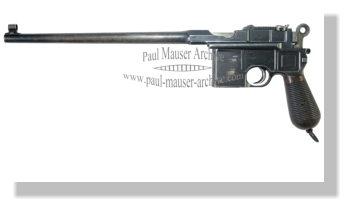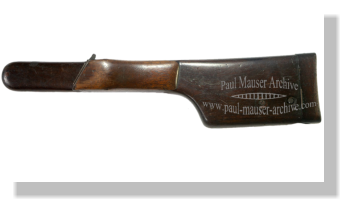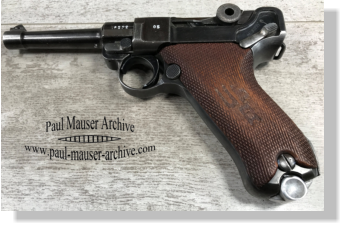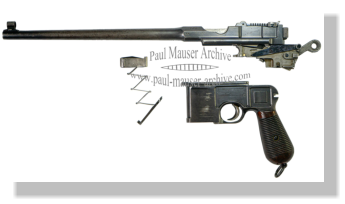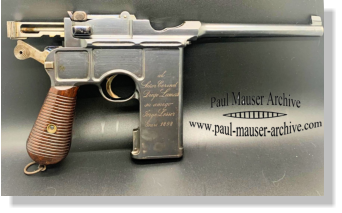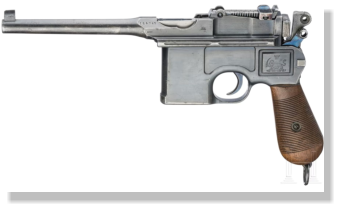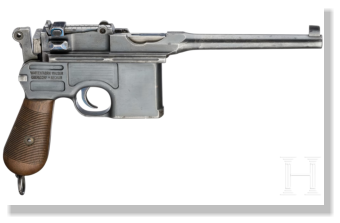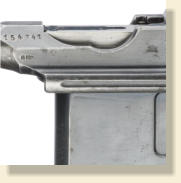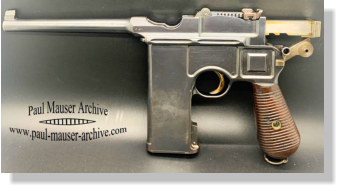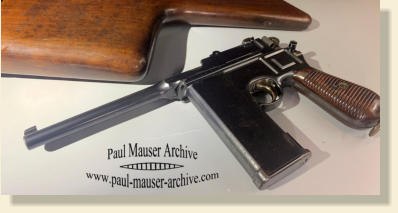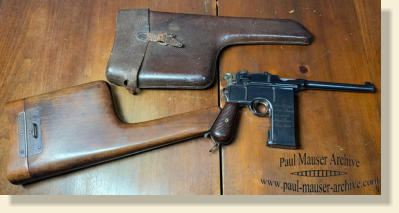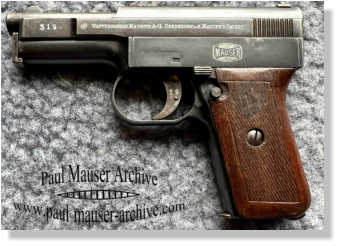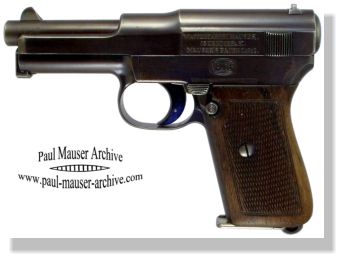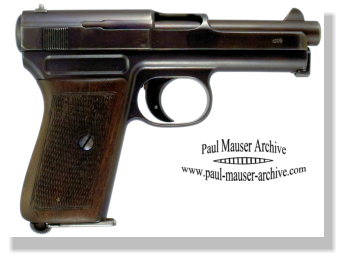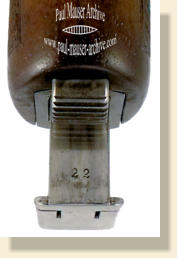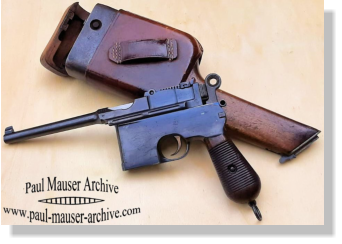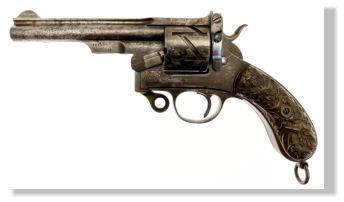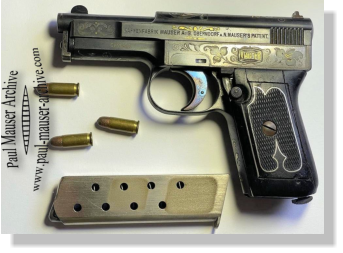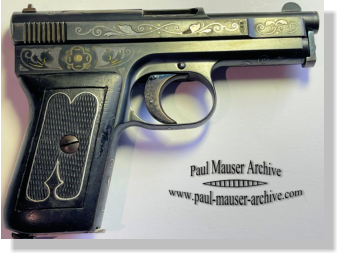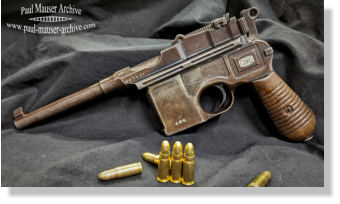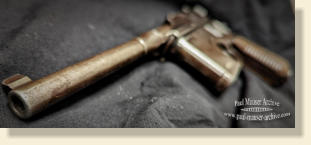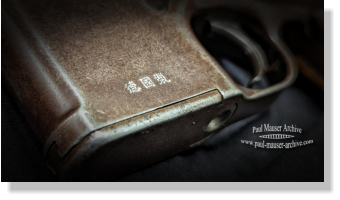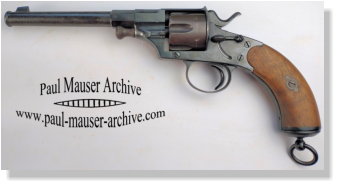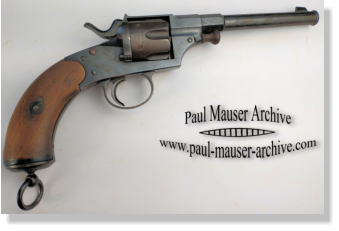Paul Mauser Archive Certification
Service for Mauser and Luger
Pistols
The study of the historical records in the Paul Mauser Archive provides unique information on handgun production from 1877 to 1999. This unique information is now made available to museums, collectors and auction houses through the certification service offered by the Paul Mauser Archive. Much of the information available on the Internet and also published years ago in many books is not accurate and was essentially based on personal assumptions of the authors. The Paul Mauser Archive provides in its certificates certain data based on documentary evidence directly from historical Mauser documents. Associating your Mauser pistol with a certificate from the Paul Mauser Archive increases its historical and collector interest by allowing you to appreciate unique historical aspects based on documentation from the time of manufacture. Anyone who owns a Mauser pistol and wants to know the history of that gun can contact the archive: mauser.archive@gmail.com Certification is based upon the availability of important Archive documents (Paul Mauser and Mauser Company Archive, Joachim Görtz Archive), the publication of books and articles on the subject, and authoritative assessment of value. A special mention goes to the Mauser Parabellums (INTERARMS) produced after in 1969, for which production books are also still available: Mauser Parabellum (INTERARMS) Certification Service. It is important to note this disclaimer aspect: the certificates reflect Archive studies, that is, historical aspects of the gun based on the original documentation of the period. Technical aspects are covered only if the technical documentation of the time is available in the Archive. Therefore, the certificates are not conclusive in clarifying technical doubts about possible alterations the gun may have had over the years, such as when and how a caliber change occurred or whether the bluing is in its original state or not...
Artillery Luger pistol and Mauser Parabellum
Artillery Luger


© Mauro Baudino 2023 - all rights reserved








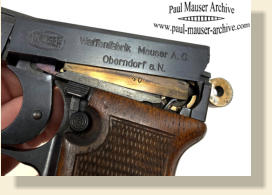

Mauser Nickl pistol with rotating barrel model 1916/22
I recently had the opportunity to study this rare Nickl pistol model 1916/22 as part of the certification service offered by the Paul Mauser Archive. The pistol in reference is Serial number 40, and chambered in 9mm Nickl caliber. It was a piece of the Bobby O’Shield’s collection. Bobby was a lifelong member of South Carolina Arms Collector's Association for over 50 years where he served as the show director, secretary, and treasurer. Josef Nickl was not part of the “first generation” of technicians working with Paul Mauser. He was a talented engineer who joined Mauser in 1904 and led the V-Abt (Versuchsabteilung – Experimental Department) from 1913 until 1930. He was involved in several pistol related activities when Paul Mauser was still alive, and was the main engineer involved in the creation of the “family concept” which was introduced with the successful Model 1910 pistol. We see his name recurrently recorded in several calculation books. When responsible for the Versuchsabteilung, he worked in close collaboration with Fidel Feederle. Nickl worked on different technical aspects but one of them was related to the solution of the problems related to the delayed blowback concept originally applied on the C06/08 pistol and then on the 1912/14. The idea was to replace the flap delay mechanism with a rotating barrel similar to the one used in the Steyr M1911 pistol. Due to the rotation and the resulting friction, the backward movement of the slide was delayed. Nickl developed in this period a specific caliber for his own pistols, the 9mm Nickl that was similar but not identical to the 9mm Browning short (9x17mm). Pistol chambered for the 9mm Nickl can only use Nickl cartridges. The Paul Mauser Archive preserves some of the original Nickl patents as well as data of the few sales of this pistol in the Original Mauser Sale Books. The pistol is now accompanied by a seven pages certificate that describes all the details of the pistol based on the data available in the Paul Mauser Archive.Rare Long barreled C96 pistol with stock
These kind of discoveries gratify me a lot! The research carried out as part of the certification service offered by the Paul Mauser Archive is extremely rewarding both for those who conduct it and for those who receive the certificate. I always find it interesting to analyse Mauser pistols and try to trace their history through the available historical documentation. Such interest in archival research is certainly greater when faced with unique or extremely rare guns, and the possibility of finding information about them gratifies the hours spent in the archive. A few months ago, I was contacted by the lucky owner of this exceptional Mauser C96 who asked me a simple question: "Can you tell me something about this C96 in an unusual configuration?". I had the opportunity to study and certify different C96 carbines produced in different periods but this C96 cannot be categorized as a carbine. The long barrel made me think that once, in one of the first sales books tracing the Mauser C96, I came across a sale of not better clarified long barrel C96, but I could not remember neither the details nor when. So I set out in search of such a sale and after a short time I found it again and to my great pleasure, this sale referred exactly to a group of C96s in this configuration. In fact, Westley Richards, the first UK importer to obtain exclusive rights to market C96s in England as well as the British Colonies, Scotland and Ireland, ordered in 1898: “6 long-barrel C96 pistols with corresponding wooden holster stock.” A few lines further down another sale, this time to Mahillon, the official Belgian importer, who ordered a C96 with special-order bead front sight. Simply fantastic, in the same page it is shown the possibility to order to Mauser, long barrel C96 pistols with corresponding wooden holster stock and also with the "Perlkorn", bead front sight. All the details are obviously available in the certificate I produced for the owner of this great C96. These kind of discoveries gratify me a lot! Those interested in the certification service can contact the Archive at the following email address: mauser.archive@gmail.comRare Carbine Large Ring Hammer serial number 595
I have recently certified this nice and rare C96 Carbine based on period documents available in Paul Mauser's Archive. This allowed me, among other things, to make a complete inventory of the Carbines sold by Mauser between 1897 and 1913. The certification service offered by the Paul Mauser Archive is a unique opportunity to associate to your Mauser pistol a certificate based on the original Mauser documentation of the period. If you are interested in the certification service , please contact me at the following address: mauser.archive@gmail.comC96 sold by John Rigby in 1898
I recently had the opportunity to certify as part of the certification service offered by the Paul Mauser Archive, this interesting early C96 serial number 2008, sold by the British dealer John Rigby Co. in London. The certification of the C96 sold to the English dealers Westley Richards Co. and John Rigby Co. give a lot of gratification because in some cases it is possible to trace the complete history from the order in Mauser to the retail sale of the gun in England. This complete traceability is not easy to achieve, and when I do succeed, I am very pleased. The gun was sold by Mauser to Westley Richards Co. in Birmingham; Westley Richards was the exclusive distributor of the Mauser C96 in England, the British colonies, Scotland and Ireland. The C96 was then sold to John Rigby Co. who finally sold it on July 2, 1898 to a certain Major Hely (or Mely). If you are interested in the certification service offered by the Paul Mauser Archive you can write to: mauser.archive@gmail.comStunning Mauser C96 Cone-Hammer 20-shot
I was contacted by a collector from South America who asked me to certify his Mauser C96 based on the period data preserved in the Paul Mauser Archive. As soon as I opened the photos sent in attachment to the email, I was speechless to see this wonderful rig, composed by a C96 20-shot serial number 368 with dedication on the magazine, the shoulder-stock and a holster for the whole set. The pistol was a gift to a high-ranking officer as you can read from the dedication. The research in the Archive, in the sales documents, has not been particularly complex, in fact the number of C96 20-shot sold per year is extremely limited and therefore easy to find. The Paul Mauser Archive preserve all the sales statistics of the C96 from the beginning of production until 1913, even if sales of the 20-shot model stopped well before. It was therefore possible to trace the sale of the gun to the German exporter who then sent the pistol to Argentina. The collector was particularly happy with the unique historical data from the original Mauser documents of the period available in the certificate. If you are interested in the certification service offered by the Paul Mauser Archive you can write to: mauser.archive@gmail.comEarly Mauser Model 1910 Sidelatch
Recently I had the opportunity to study and certify, based on historical documents preserved in the Paul Mauser Archive, this early production Mauser pocket pistol Model 1910 'Sedelatch'. The serial number is low, 319, and it was produced literally in the early days that Mauser began mass production of the Model 1910 as reported in the internal Mauser documentation of the period. The pistol has some typical aspects of the early production, which are still derived from the prototypical 1909 Model,. Paul Mauser himself, with Fidel Feederle and mainly Josef Nickl are the main designers of this model. The Model 1910 is, together with the later variations M1910/14 and M1910/34, the most successful variations of the “pistol family” concept that Nickl introduced from late 1908. The idea was to define a new pistol design for a 9x19 Parabellum caliber and then scale down into smaller calibers. The reason behind this idea was the possibility of simultaneously competing, using the same design, against both the Parabellum (Luger) and the smaller Browning 7.65 mm (.32 ACP). If you are interested in receiving information about the Model 1910 and later based on archival documentation, you can request a certificate from the Paul Mauser Archive: mauser.archive@gmail.comMauser Humpback #22
I have been contacted by the collector who owns this remarkable Mauser Humpback #22 with an interesting question. In fact, it was not a typical certification based on the documents of the period, but rather a search in the Glass Plate photographs Archive. In fact, the collector had seen a vintage photo of his pistol in a book. The image shows the pistol being held with two hands and the slide is being pulled back just enough for the barrel lug serial number to be seen. As soon as the photo was shown to me, it was immediately evident that it was one of the shots taken for the user manual. The Photographic Archive on glass plates preserves many of these photos related to the handling and disassembly of the gun that were used in the manuals of the period. The research in the Archive has been fruitful and has allowed the finding of the original photo, a copy of which has been sent to the collector who can now associate it with the pistol. With regard to the Mauser in discussion, this is a rare very early Humpback, serial number 22. It features a 3-line slide address and the Patent date "1912". The Humpbacks were the first version of the 1910 design produced in 7.65 mm. Humpbacks have several differences, which seem to be evidence of the design's evolution during early development for marketing and/or manufacturing reasons. The magazine is numbered on the back bottom of the body. I would like to remind you the certification service offered by the Paul Mauser Archive for Mauser pistols. Whoever is interested can contact the Archive: mauser.archive@gmail.comItalian Royal Navy Contract C96
As part of the certification service offered by the Paul Mauser Archive, I certified this C96 Italian contract, providing much useful historical information about the pistol including its shipment to the Italian arsenal. The Paul Mauser Archive preserves the contractual, sales and maintenance documentation for the Royal Italian Navy contract. Of this contract as well as for the Turkish/Ottoman one a few years earlier and the Persian one that follows by a few years, the Archive preserves essentially all the original documentation. I would like to remind you the certification service offered by the Paul Mauser Archive for Mauser pistols. Whoever is interested can contact the Archive: mauser.archive@gmail.comMauser Parabellum pistol Üb 1939-S/42
As part of the certification service offered by the Paul Mauser Archive, I have certified this rare Mauser Parabellum 1939-S/42 pistol that is part of the Üb marked model. The paul Mauser Archive preserves a big amount of historical documents about the Mauser Parabellum production. These Mauser P/08 have been produced to train shooters to pass the last part of pistol acceptance, which was the so-called Anschuss (accuracy test). The Üb pistols were assembled from all kinds of obsolete parts, they look heavily used. I would like to remind you the certification service offered by the Paul Mauser Archive for Mauser pistols. Whoever is interested can contact the Archive: mauser.archive@gmail.comC78 (Zick-Zack) revolver in 9mm caliber
Another interesting certification and another collector enthusiastic about the historical information received from the Paul Mauser Archive. In this case, it is an early C78 “Zick-Zack" Revolver in 9mm caliber. The certificate was produced based on historical documentation preserved in the Archive. The revolver is not in mint condition, but C78s are rare in any condition. This model bears an interesting inscription from one of its owners "PIUS STANGE, MECHANIKER. 1914". After the less than enthusiastic reception of the C77 Single Shot Handgun, Mauser decided to enter into the arena of the multiple-shot revolver with a new and ingenious design, the C78. Paul Mauser was really convinced of the superiority of his C78 mechanism compared to the standard revolver and the fact that it was considered to be inadequate by the German Army was certainly a frustration for him. I would like to remind you the certification service offered by the Paul Mauser Archive for Mauser pistols. Whoever is interested can contact the Archive: mauser.archive@gmail.comFactory Engraved Mauser Model 1910 Sidelatch pistol
I was recently contacted by a South American collector who requested the Paul Mauser Archive to certify this fine engraved Mauser Model 1910 Sidelatch. The finely crafted gun presents considerable interest. The name “sidelatch” comes from the fact that these pistols had a small rotating disassembly lever built into the side plate. Paul Mauser himself, with Fidel Feederle and mainly Josef Nickl are the main designers of this model. The Model 1910 is, together with the later variations M1910/14 and M1910/34, the most successful variations of the “pistol family” concept that Nickl introduced from late 1908. The Paul Mauser Archive preserves essentially all design (blueprints), cost evaluation, glass plates photos and sales documentation of that model. Those interested in receiving a certificate from the Paul Mauser Archives can contact the Archives here: mauser.archive@gmail.comMauser C96 M1930 exported in China.
Recently, as part of the certification service offered by the Paul Mauser Archive, I had the opportunity to study and certify, based on historical archival documentation, this interesting C96 Model 1930 exported to the Chinese market. China was the most important market for the Model 1930 and in general one of the most important markets for Mauser. The inscription in Chinese characters "Made in Germany" is interesting. The Paul Mauser Archive preserves essentially all orders addressed to China through the official exporter. Those interested in the certification service for Mauser pistols from 1877 to 1999 can contact the Archive: mauser.archive@gmail.comReichsrevolver M79 (Model 1879)
As part of the certification service offered by the Paul Mauser Archive for Mauser pistols, I recently studied this example of Reichsrevolver Model 1879 (M79). The Paul Mauser Archive preserves the original documents of the acquisition of the Reichsrevolver Model M83 and M79 between Mauser and the Kingdom of Württemberg. The Reichsrevolver M79 was also sold to Bavaria. Between 1877 and 1878 a military commission was established with the aim of evaluating current revolver technology to unify and standardize the pistols in use within the different forces of the German Kingdoms. The Model 1879 revolver and the lighter version Model 1883 were retained and thoroughly tested by the Spandau (GPK) commission. The Model 1883 had a shorter barrel and the frame ahead of the cylinder was substantially reduced in thickness and weight. Paul and Wilhelm Mauser participated in this competition with their Revolver C78 (Zick-Zack). Paul Mauser was convinced of the superiority of his revolver compared to the standard revolver and the fact that it was considered to be inadequate by the German Army was certainly a frustration for him. If you are interested in the certification service, please contact the Paul Mauser Archive: mauser.archive@gmail.comMauser C96 Persian Contract
The Paul Mauser Archive recently certified this beautiful C96 Persian Contract. The Paul Mauser Archive has done extensive studies on this contract based on the historical documentation preserved in the Archive. The first letter outlining Persia’s interest in the purchasing Mauser C96 is dated Dec. 30 1907 but several years were needed to finalize the order. The entire chronology of events is available and we can now know how many of the pistols in the contract were actually shipped to Persia and how many remained unsold in Mauser and ere later used in different contexts. It is therefore possible to trace the complete history of this model. Lucky owners of one of the rare Persian Contract Mauser C96 can therefore contact the Paul Mauser Archive to receive a certificate with the correct history of the pistol: mauser.archive@gmail.com Thanks to Hermann Historica for the permission to use the photos.Mauser Parabellum Persian Contract
Just above I presented the Mauser C96 Persian Contract. The owner of both pistols, required to certify also the Mauser Parabellum Persian Contract I present here. The Paul Mauser Archive preserves the contract, production and delivery information of both models. Both models are characterized by having the Persian emblem/crest whose original design, used on the pistols and rifles sold to Persia, is preserved in the Paul Mauser Archive. The Parabellum, unlike the C96, has Farsi numbering. Anyone interested in havin their Mauser pistol studied and receiving a certificate on the basis of period Mauser documentation can contact the Archive: mauser.archive@gmail.com Thanks to Hermann Historica for the permission to use the photos.Spectacular Mauser C96 Cone-Hammer with accessories.
The Paul Mauser Archive was recently contacted to produce a certificate with all the accurate information regarding the history of this spectacular Mauser C96 Cone-Hammer. The Archive provided the certificate summarizing its history from the manufacture to the shipment. Such a Mauser C96 Cone-Hammer is part of a lot well listed in Mauser documentation of the time exported to the U.K.



Some examples of certified handguns of historical and
collectible significance
The Churchill Mauser C96 Pistols
Definitely, one of the most interesting certifications has been the one of the Mauser C96 belonged to Winston Churchill. Churchill acquired at least three C96 pistols that he used in the Boer War in South Africa in 1899 – 1900 time-frame. Churchill preferred to use his Mauser instead of saber in close combat as he himself wrote: “Before we wheeled and began to gallop the officers had been marching with drawn swords. On account of my shoulder I had always decided that if I were involved in hand-to-hand fighting I must use a pistol and not a sword I had practiced carefully with [the Mauser] during our march and journey up the river. This then was the weapon with which I determined to fight. I had first of all to return my sword into its scabbard, which is not the easiest thing to do at a gallop. I had then to draw my pistol from its wooden holster and bring it to full cock…” Three Mauser C96 pistols were purchased by Churchill from the John Rigby Co. dealer in London. In this post, we refer in particular to the C96 number 4257 which was purchased by Churchill on November 1, 1898 when he was in London for a home leave period. The current owner of the C96 pistol was already in contact with the Churchill Archive and he received from this institute documents on the pistol. The acquisition and sale of this gun is tracked in Rigby's inventory and sales records. It was possible to track this gun back to see if it was possible to trace it in Mauser's internal documents. In a note taken at the beginning of 1898 in Paul Mauser's diary it is written: “Westley Richards & Co. Limited: Birmingham. Have a dealership for the United Kingdom England, Scotland and Ireland.” It means that, from the beginning of 1898, Westley Richards Co. was the exclusive distributors for the Mauser C96 in England as well as the British Colonies, Scotland and Ireland. In the year 1898, John Rigby Co. acquired Mauser C96 pistols from the Westley Richards Co in Birmingham. It was therefore necessary to look in the Mauser sales books for an order from Westley Richards that was compatible with the sale to Rigby and then to Churchill. It should be noted that Mauser's sales books do not track the serial numbers of the weapons purchased but only the total number of weapons sold. Correlating therefore the information present in the administrative documents of Westley Richards Co. and John Rigby Co. it was possible to identify the order of Westley Richards to Mauser that most likely contains the C96 of Mr. Winston L. S. Churchill. In fact, on June 30, 1898, an order of 100 Mauser C96 pistols was sent to Westley Richards at Birmingham. There are no further acquisitions of C96 pistols by Westley Richards after the June acquisition and before November when the pistol was sold to Churchill.Engraved Mauser C96 Ottoman Contract - 1897
It was a great pleasure certifying this beautifully engraved Mauser C96 Ottoman contract as part of the certification service offered by the Paul Mauser Archive. I thank the privileged owner for allowing me to present it, this is the first time such a pistol has been published. The small Mauser C96 “Cone Hammer” contract with Turkey dated 1897 is part of the Sultan Abdul Hamid II modernization program, and it is historically important for two reasons: It is the first military contract for a semiautomatic pistol in history and it is a unique military contract for the “Cone Hammer” variation. The small number of pistols was acquired for the Palace Sultan Guard in Constantinople and it was good advertising for Paul Mauser, which helped stimulate military interest in his new pistol. The study of this C96 pistol has allowed us to understand that it was decommissioned and purchased privately probably in 1906 and was engraved by the Ottoman Master Engraver Abdullatif in Berlin in the year 1324 of the Hijri calendar, which is equivalent to 1906‐1907. The fact that the pistol was engraved in Germany is not surprising because in those years there were many Turkish Officers and NCO serving in both Berlin and Oberndorf. In fact, at that time, two Ottoman acceptance commissions were active in Germany, one in Mauser in Oberndorf for the acceptance of guns (rifles and pistols), the other in Karlsruhe for the verification of the ammunitions. I would like to thank my friend Ertuğrul Kasacı for the translation from Ottoman Turkish language. The Paul Mauser Archive preserves most of the historical documentation related to the contract between Mauser and the Ottoman Empire for the acquisition of the 1000 Mauser C96 in 1897.C78 (Zick-Zack) revolver in 7mm caliber
In 1878, the Mauser brothers patented the C78 revolver essentially in two configurations with Solid and Hinged Frame (like the one presented in the photos). The Mauser documentation of the time gives us interesting information on the history of this model and on the unsuccessful attempts of Wilhelm Mauser to convince the German technical services (Gewehrprüfungkommission - GPK, Spandau) of the suitability of this model in caliber 10.6mm for military use. The Nickel (Vernickelt) finishing was applied since the beginning of the C78 production and the original Mauser sales documents report that it was slightly more expensive than the normal finishing.